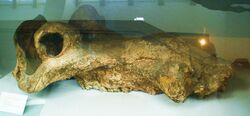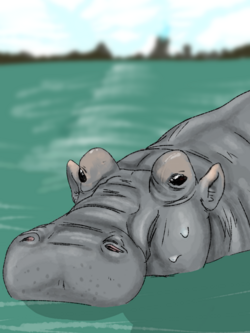Biology:Hippopotamus gorgops
| Hippopotamus gorgops | |
|---|---|

| |
| Scientific classification | |
| Domain: | Eukaryota |
| Kingdom: | Animalia |
| Phylum: | Chordata |
| Class: | Mammalia |
| Order: | Artiodactyla |
| Family: | Hippopotamidae |
| Genus: | Hippopotamus |
| Species: | †H. gorgops
|
| Binomial name | |
| †Hippopotamus gorgops Dietrich, 1928
| |
Hippopotamus gorgops is an extinct species of Hippopotamus. It first appeared in Africa during the late Pliocene. It became extinct during the Middle Pleistocene.[1]
Taxonomy
The species was described by German scientist Wilhelm Otto Dietrich in 1928.[2] It is closely related and possibly ancestral to the European species Hippopotamus antiquus.[3] Remains assigned to H. gorgops and H. behemoth are known from the Ubeidiya locality in Israel, dating to approximately 1.6 million years ago, with some authors suggesting that H. behemoth is actually a synonym of H. gorgops, given their similar morphology.[4][5]
Description
With an estimated length of 4.3 metres (14 ft), a shoulder height of 2.1 metres (6.9 ft), and a weight of 3,900-4,500 kg (8,600-9,900 lb), H. gorgops was larger than its living relative, H. amphibius. Another feature setting it apart from H. amphibius was the placement of its eyes. Modern hippos have eyes placed high on the skull, but H. gorgops had eyestalk-like orbits extruding above its skull, making it even easier for the creature to see its surroundings while (almost) fully under water.[6]
References
- ↑ van der J. Made, M. Sahnouni, Kamel Boulaghraief Hippopotamus gorgops from El Kherba (Algeria) and the context of its biogeography M. Sahnouni, S. Semaw, J. Rios Garaizar (Eds.), Proceedings of the II Meeting of African Prehistory, Burgos 15–16 April 2015, Centro Nacinonal de Investigación sobre la Evolución Humana - Burgos (2017), pp. 135-169
- ↑ Dietrich, W. O. (1928). Pleistocäne Deutsch–Ostafrikanische Hippopotamus–reste. Wissenschaftliche Ergebnisse des Oldoway Expedetion Herausgeben Von Prof. Dr. Reck, 3: 3–41.
- ↑ Martino, Roberta; Ríos, Maria Ibanez; Mateus, Octavio; Pandolfi, Luca (December 2022). "Taxonomy, chronology, and dispersal patterns of Western European Quaternary hippopotamuses: New insight from Portuguese fossil material" (in en). Quaternary International: S1040618222003901. doi:10.1016/j.quaint.2022.12.010. https://linkinghub.elsevier.com/retrieve/pii/S1040618222003901.
- ↑ TCHERNOV, E (1986). "Les mammifères du Pleistocène inférieur de la vallée du Jourdain à Oubeidiyeh". Israel J. Earth Sci. 36: 3–36. https://pascal-francis.inist.fr/vibad/index.php?action=getRecordDetail&idt=7511126.
- ↑ Martínez-Navarro, B (2010). "The fossil Bovidae (Artiodactyla, Mammalia) from Gesher Benot Ya’aqov, Israel: Out of Africa during the early-middle Pleistocene transition". J. Hum. Evol. 60: 375–386. https://www.researchgate.net/profile/Rivka_Rabinovich/publication/50363006_The_fossil_Bovidae_Artiodactyla_Mammalia_from_Gesher_Benot_Ya%27aqov_Israel_Out_of_Africa_during_the_Early-Middle_Pleistocene_transition/links/59eba337aca272cddddefc2e/The-fossil-Bovidae-Artiodactyla-Mammalia-from-Gesher-Benot-Yaaqov-Israel-Out-of-Africa-during-the-Early-Middle-Pleistocene-transition.pdf.
- ↑ Palmer, D., ed (1999). The Marshall Illustrated Encyclopedia of Dinosaurs and Prehistoric Animals. London: Marshall Editions. p. 268. ISBN 1-84028-152-9.
- Petronio, C. (1995): Note on the taxonomy of Pleistocene hippopotamuses. Ibex 3: 53–55. PDF fulltext
Wikidata ☰ Q2483571 entry


